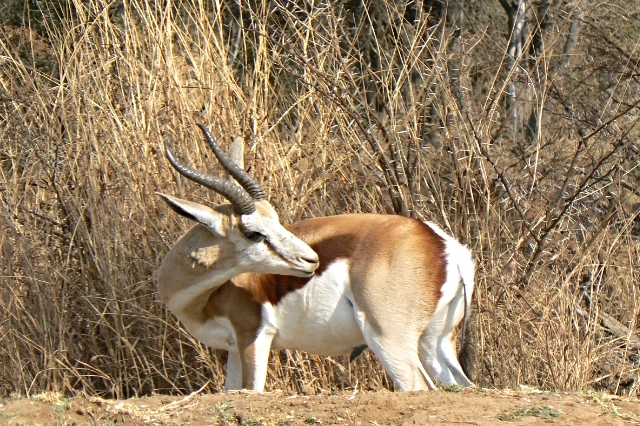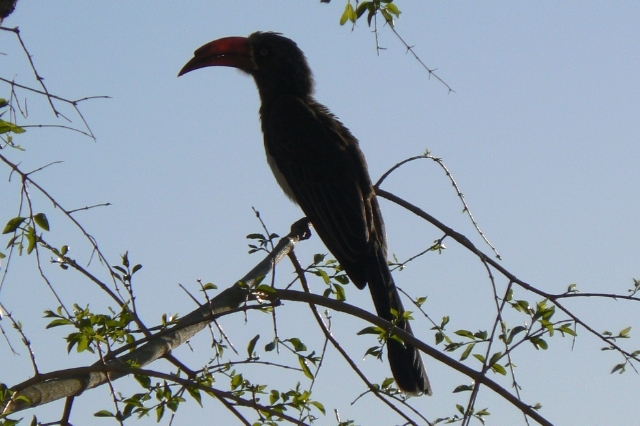
Pilanesberg, 15 August 2014
Rams may weigh up to 50 Kg, and ewes only up to 37 Kg. Their striking body colour renders them easily recognizable. Shoulders appear lower than the hindquarters. Cinnamon coloured upper body, white underparts and a broad dark brown stripe on either flank stretching from the front legs to the rear legs. The short white tail is brown tufted. The rump is marked by a triangular-shaped white patch, framed by a dark brown stripe with the apex on the top of the hindquarters. Horns of ewes are more slender and shorter than those of rams.
Springboks are selective feeders, whose diet comprises the best fodder available at any given time. They browse in the dry season and predominantly graze after the rainy season when grasses spout green. They are fond of flowers such as of Acacia, and drink water readily, but when open water is scarce, water requirements are met by eating moisture-rich tubers and roots.
Mating is normally restricted to a one or two week rut, although this specie is capable to breed at any time of the year. After a gestation period of 25 weeks single lambs are born. Lambs are hidden for the first two days after birth. Most ewes breed every year, some even twice. Young are weaned at about four months and ewes become sexually mature at the age of seven months.
Only rams establish territories for mating opportunities. The exception is territorial rams, which prefer to live in the solitude of their territories. Herd composition is flexible.
Historically, the Springbok's range covered the central and western regions of southern Africa, with a marginal extension into southwestern Angola. The species still occurs very widely within its historical range, but in Angola it survives in greatly reduced numbers.
In South Africa, the Springbok was exterminated over much of its natural range during the course of the late 1800s as a result of hunting and the effects of rinderpest. However, it has subsequently been reintroduced widely to private land and protected areas throughout its former range. The largest numbers occur on private game farms, mainly in the highveld of the Free State and Gauteng provinces and the Karoo and Kalahari thornveld of the Western, Eastern and Northern Cape provinces.
Smaller, introduced populations occur widely in extralimital areas, e.g., on private land and provincial reserves in parts of KwaZulu-Natal and the northern bushveld.
The Springbok formerly occurred in huge numbers in the dry grasslands, bushland and shrubland of south-western and southern Africa, migrating sporadically in vast herds (treckbokken) in some of the southern parts of its range. These migrations or treks no longer occur, but some indication of the species’ former abundance can still be seen in seasonal concentrations on the areas of short vegetation which it prefers, e.g., in parts of the section of the Kalahari which lies in central and southern Botswana. Springbok are primarily browsers, but do also take grass, favouring young succulent grass before it begins to lignify.









